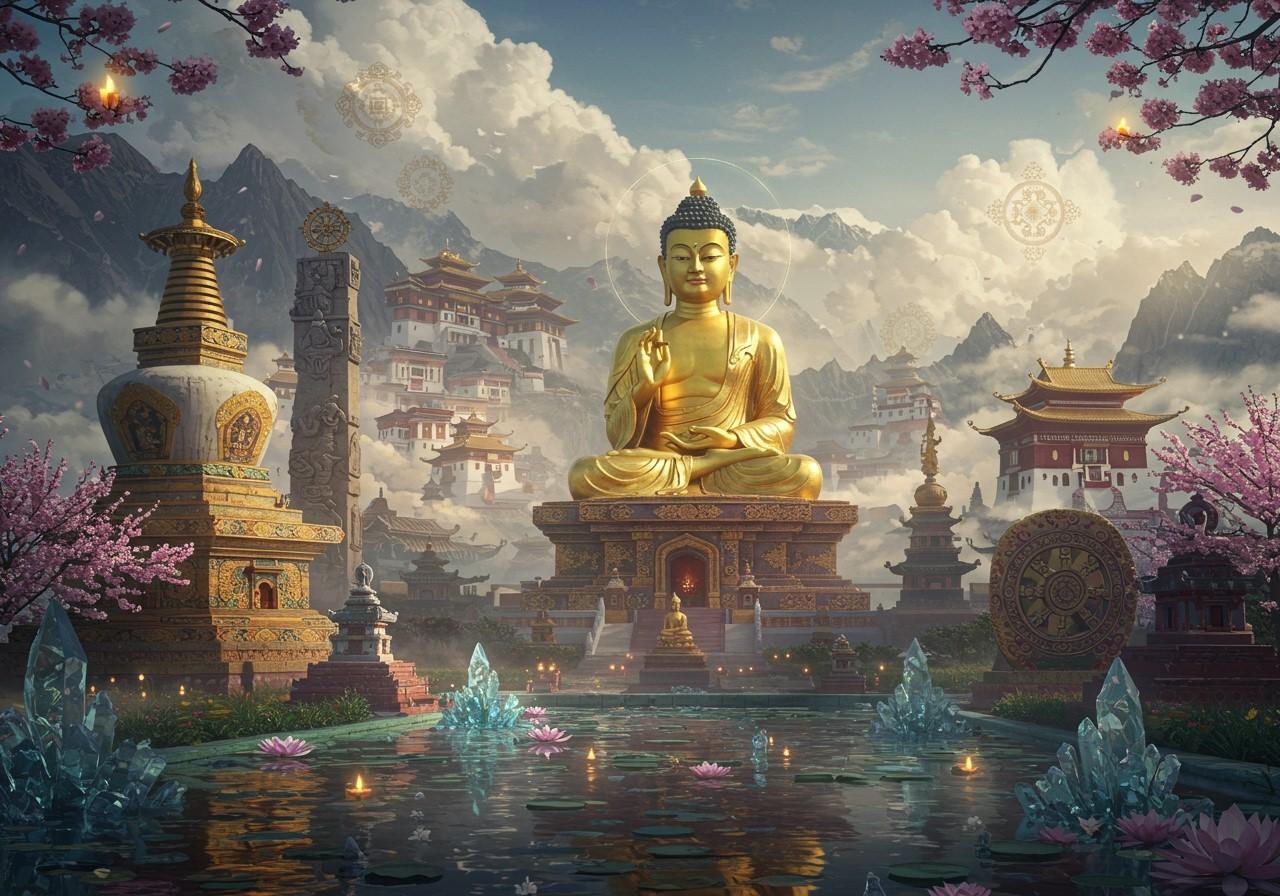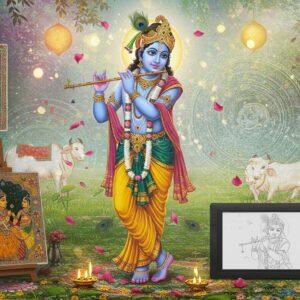
Buddhist art and architecture hold deep meaning for practitioners, reflecting the core principles and rich heritage of this ancient faith. This exploration delves into the profound significance of Buddhist artistic and architectural traditions.
A Journey Through Time: The Evolution of Buddhist Art and Architecture
Originating in ancient India around the 6th century BCE, following the Buddha’s enlightenment, Buddhist art and architecture have left an indelible mark on cultures across Asia. Initially simple, these forms evolved into magnificent temples and monasteries, reflecting the spread and adaptation of Buddhist teachings.
- Early Stupas (c. 3rd Century BCE): These foundational structures served as reliquaries, housing sacred remains of the Buddha and prominent disciples. Their simple dome-like form became a potent symbol of the Buddha’s parinirvana, representing his release from the cycle of rebirth.
- Ashoka’s Influence (c. 3rd Century BCE): Emperor Ashoka’s fervent patronage played a pivotal role in disseminating Buddhist art and architecture across the Indian subcontinent. He commissioned numerous stupas, pillars inscribed with edicts, and monasteries, establishing a visual language for the burgeoning faith.
- Regional Diversification (1st Century CE onwards): As Buddhism spread across Asia, it interacted with local traditions, giving rise to distinct regional styles. From the rock-cut caves of Ajanta and Ellora in India to the towering pagodas of China and serene temples of Japan, each region developed its own unique expression of Buddhist art and architecture.
Architectural Elements: Symbols of Buddhist Teachings
Buddhist architecture employs various elements, each imbued with symbolic meaning, creating spaces conducive to contemplation and spiritual practice.
- Stupas: Representing the Buddha’s enlightened mind and often containing relics, stupas evolved into elaborate structures adorned with symbolic carvings and gateways, serving as focal points for pilgrimage and devotion.
- Pagodas (1st Century CE onwards): Originating in East Asia, pagodas, with their tiered roofs, developed from the stupa form. They often house sacred texts and images, symbolizing the ascent towards enlightenment.
- Viharas: Monasteries, or viharas, provide a communal living space for monks, fostering an environment of study, meditation, and spiritual practice. These spaces often feature courtyards, libraries, and meditation halls.
- Chaityas: Prayer halls, or chaityas, serve as spaces for communal worship and contemplation. Often carved into rock faces or built as freestanding structures, they house images of the Buddha and provide a setting for religious gatherings.
- Mandalas: These sacred diagrams, representing the cosmos and the Buddha’s enlightened mind, are often incorporated into temple layouts and rituals. They serve as visual aids for meditation and symbolize the interconnectedness of all things.
Traditional materials like stone, wood, and brick are favored for their natural qualities and symbolic resonance. Gardens and water bodies, often integrated into temple complexes, create serene environments conducive to reflection and spiritual practice.
Iconography and Symbolism: A Visual Language of Enlightenment
Rich in symbolism, Buddhist art employs a visual language that conveys profound spiritual concepts and narratives.
- Mudras: Symbolic hand gestures, or mudras, convey specific meanings related to the Buddha’s teachings and different states of being. For instance, the dhyana mudra signifies meditation, while the abhaya mudra represents fearlessness and protection.
- Bodhisattvas: These enlightened beings, depicted in various forms, embody compassion and the commitment to guiding others towards enlightenment. Their serene expressions and symbolic attributes inspire devotion and emulation.
- Symbols: Recurring symbols, such as the lotus flower (purity), the dharma wheel (the Buddha’s teachings), and the vajra (spiritual power), reinforce core Buddhist principles and provide visual cues for contemplation.
Jataka tales, narrating the Buddha’s previous lives, are often depicted in vibrant murals and sculptures, conveying moral lessons and inspiring virtuous conduct. The preservation of ancient frescoes, murals, and statues is essential for safeguarding this rich artistic heritage.
Regional Variations: A Tapestry of Cultural Influences
Buddhist art and architecture showcase a remarkable diversity of regional styles, reflecting the interplay between Buddhist teachings and local cultural traditions.
Indian Buddhist Architecture (c. 3rd Century BCE onwards)
From the magnificent rock-cut caves of Ajanta and Ellora, adorned with intricate carvings and vibrant frescoes, to the imposing stupas of Sanchi, Indian Buddhist architecture showcases the early development of Buddhist artistic expression, laying the foundation for later regional variations.
Explore the architectural wonders of Akshardham Temple: https://www.poojn.in/post/16887/akshardham-temple-architectural-wonders-explained
Tibetan Buddhist Architecture (7th Century CE onwards)
Characterized by vibrant colors, intricate ornamentation, and imposing structures like the Potala Palace and Jokhang Temple, Tibetan Buddhist architecture embodies the unique cultural and spiritual landscape of the Tibetan plateau.
Embark on a spiritual journey to Mata Mansa Devi Mandir: https://www.poojn.in/post/16899/spiritual-journey-mata-mansa-devi-mandir-chandigarh-a-guide
Chinese Buddhist Architecture (1st Century CE onwards)
From the monumental Longmen Grottoes, housing thousands of Buddha statues carved into cliffs, to the iconic tiered pagodas, Chinese Buddhist architecture demonstrates a synthesis of Buddhist principles and Chinese aesthetics.
Japanese Buddhist Architecture (6th Century CE onwards)
Known for its serene simplicity, harmony with nature, and iconic structures like the Todai-ji Temple and Kinkaku-ji (Golden Pavilion), Japanese Buddhist architecture reflects the unique cultural and spiritual values of Japan.
Discover a beginner’s guide to yoga: https://www.poojn.in/post/16893/beginner-yoga-simple-poses-easy-introduction
Southeast Asian Buddhist Architecture (8th Century CE onwards)
Southeast Asian Buddhist architecture, exemplified by the magnificent Angkor Wat in Cambodia and the majestic Borobudur in Indonesia, showcases intricate carvings, towering structures, and a fusion of Buddhist and Hindu influences.
Shop Buddhist Art & Ritual Items at Poojn.in
Poojn.in offers a diverse selection of authentic Buddhist ritual items and art pieces to enhance your spiritual practice. Our collection includes:
- Marble Dust Murti Statues: Bring the sacred presence of Buddhist deities into your home with our beautifully crafted murtis. Lord Shiva Marble Dust Murti, Radha Krishna Bigraha
- Traditional Ritual Items: Enhance your Buddhist ceremonies with our selection of bamboo chalons, dalas, and other essential ritual objects. Mangalam Camphor
Visit Poojn.in to explore our complete collection and create a sacred space for your practice.
Conclusion
The journey through the diverse expressions of Buddhist art and architecture reveals a rich tapestry of cultural exchange, spiritual devotion, and artistic innovation. These architectural marvels and artistic creations stand as testaments to the enduring power of Buddhist teachings and the profound impact they have had on cultures worldwide.
FAQs about Buddhist Art and Architecture
What is the significance of Buddhist art and architecture? Buddhist art and architecture serve as powerful expressions of Buddhist philosophy, history, and spiritual practice. They create sacred spaces for contemplation, meditation, and worship, fostering a connection to the Buddha’s teachings and the path to enlightenment.
What are the key features of Buddhist architecture? Key architectural features include stupas, pagodas, viharas (monasteries), and chaityas (prayer halls), each serving a specific function in Buddhist religious life. These structures are often adorned with intricate carvings, sculptures, and murals that depict Buddhist narratives and symbolism.
What materials are commonly used in Buddhist art? Traditional materials such as stone, wood, metal, clay, and pigments are commonly used in Buddhist art. The choice of material often reflects regional availability and cultural preferences, while also carrying symbolic meaning.
How does Buddhist art and architecture vary across different countries? Regional variations in Buddhist art and architecture reflect the dynamic interplay between Buddhist principles and local cultural traditions. From the rock-cut caves of India to the towering pagodas of East Asia, each region has developed unique stylistic expressions that reflect its specific cultural and historical context.
What is the purpose of a stupa in Buddhist architecture? Stupas serve as reliquaries, often containing sacred remains of the Buddha or other important figures. They symbolize the Buddha’s enlightened mind and serve as focal points for meditation, pilgrimage, and devotion.
How has Buddhist art evolved over time? Buddhist art has undergone a continuous evolution, adapting to different cultural contexts and incorporating new artistic styles as Buddhism spread across Asia. From early aniconic representations to later iconic depictions of the Buddha, Buddhist art reflects the changing understanding and interpretation of Buddhist teachings.
Why are there so many Buddha statues in Buddhist art? Buddha statues serve as visual reminders of the Buddha’s presence and teachings. They are objects of veneration and contemplation, inspiring practitioners to follow the path to enlightenment. Different postures and mudras of Buddha statues convey specific meanings related to his life and teachings.
What role do mandalas play in Buddhist art? Mandalas are intricate geometric diagrams that represent the cosmos and the Buddha’s enlightened mind. They serve as visual aids for meditation, symbolizing the interconnectedness of all things and the path to enlightenment.


